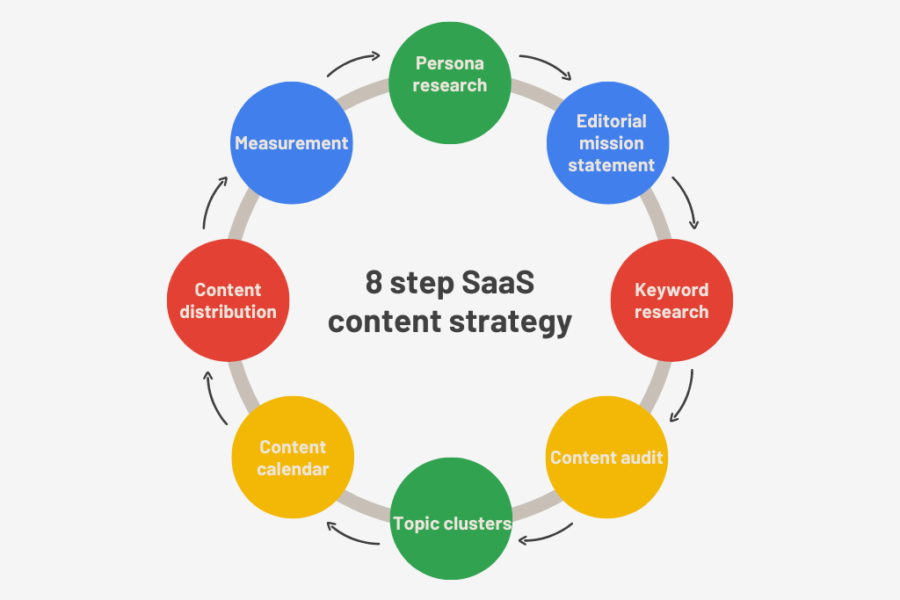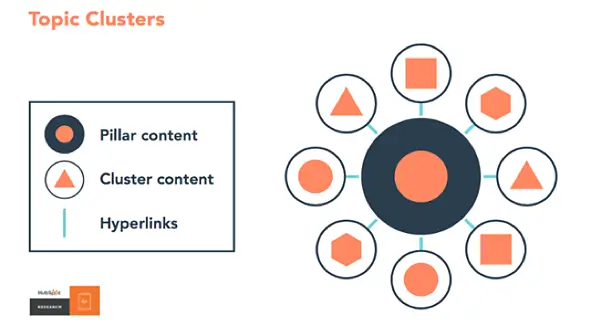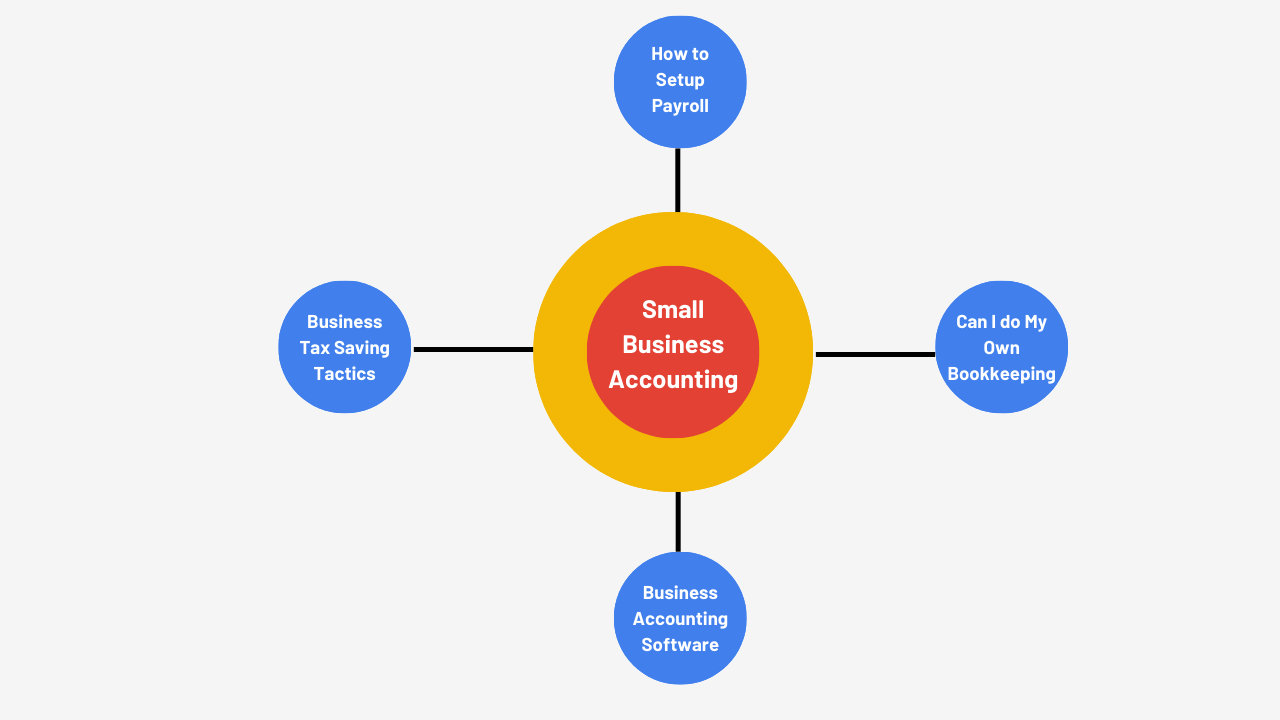A Content Strategy for B2B SaaS in 8 Steps
Alastair Kane Search Marketing, Search Marketing PartnerRead it in 12 minutes
Read it in 12 minutes
Table of contents
Today’s SaaS customers have completed a large proportion of the buying process by the time they engage with a sales rep.
In fact a Gartner study suggests that over 60% of the SaaS buyer journey occurs with no vendor interaction whatsoever.
This statistic reflects why content is pivotal in helping SaaS businesses to grow.
Lack of sales rep interaction is a trend that’s only likely to increase as Millennials and Gen Z become more involved in sales decisions. The responsibility falls to content, to provide the information needed in the SaaS purchase journey.
If you’re a B2B SaaS business without a content strategy in place, now is the time to get started!
A well rounded SaaS content strategy needs to consider long sales cycles that span many months and involve multiple stakeholders within an organisation. And as B2B SaaS products are often technically complex, content needs to be informative as well as engaging.
It is shortsighted to assume that churning out an endless ream of blog posts will break through to the prospects you’re hoping to garner attention from. A variety of content formats is needed to serve the particular informational needs at different stages of the journey.
These days it’s not enough to simply understand your customer’s pain points when embarking on a SaaS content strategy.
Knowing how prospects search for information, engage with content, and the sites they frequent helps shape your target customer profile and highlight potential obstacles to reaching them.
These insights will help you create a holistic SaaS content strategy consisting of a variety of formats (blog posts, webinars, use cases, product guides…) that can educate and engage your prospect over many months.
Keep them engaged and educated, and they will seek your brand out when they are ready to buy.
A simple concept, but not always easy to execute!
Below I have outlined an 8 step SaaS content strategy that covers everything you need to consider from the initial research phase, to measuring and reporting on performance.
Let’s dive in!

All successful marketing starts with a deep knowledge of customer pain points.
In order to understand the topics that will form your content strategy, you firstly need to have a clear idea of the challenges the target prospect seeks answers to.
One of the best places to start is by interviewing existing customers. Persona research seeks to answer questions such as:
Questions like these aim to highlight insights into the unique challenges that the prospect has that leads them to becoming a customer.
The information obtained in this step will go on to lay the foundations for keyword research, further along.
An editorial mission statement is the rudder that steers your content strategy. It directs internal resources and articulates the ‘why’ behind the strategy. It helps unify your marketing team around a common goal.
In short, the mission statement should aim to address these four things:
The information obtained in your persona research will provide the insight needed to create your statement.
Once your editorial mission statement has been created, you can be sure that relevant stakeholders within the organisation understand the reason for the strategy and the goals it’s designed to work towards.
Keyword research is a key component of a well-rounded content strategy and underpins the overarching SaaS SEO strategy.
It helps you understand what your audience is searching for, allowing you to create content that increases brand awareness and drives relevant traffic and leads from Search.
Keyword research for SaaS is more nuanced than generic research. SaaS products are often complex, and the buying cycle can be longer, involving multiple decision-makers. This means your keywords need to target various stages of the buyer journey.
You aren’t just looking for high-traffic terms; you need keywords that reflect intent and align with the specific challenges SaaS buyers face.
Here is an example of how one might tackle keyword research for a SaaS company:

A content audit helps you evaluate your business’s current content strategy and determine how effectively it serves your target audience.
Here are some points to bear in mind during a content audit:
A content audit is a fact finding mission to establish what can be used, what needs to be deleted and what needs to be created from scratch.
A topic cluster strategy is a method of grouping similarly themed topics within a website to improve organic visibility.
This strategy was first outlined by Hubspot in 2017 and involves ranking for topics rather than individual keywords.
It works by having a long form content page that targets a broad topic relevant to a business.
This long form content page is called a pillar page. It discusses the topic from a very top level perspective.
The pillar page is linked to and from a number of blog posts called clusters. These take an in depth look at the subtopics of the main topic.
From a site architectural perspective, we get something similar to a content hub (pillar content) and spokes (cluster content).

Because of the way in which related content is linked to each other, the topic cluster model provides benefits to organic visibility.
The main SEO benefits of topic clusters are:
Topic clusters work well when targeting topics that have high search volume and have enough depth to provide several related subtopics for cluster content.
Your keyword research will provide ideas for broad pillar page topics and long tail keywords that can be used for the clusters.
The image below shows what a topic cluster might look like for a SaaS business selling accounting software to small businesses.

Topic clusters may not be the right tactic for your business, but it is worth a mention here as it has proved very successful for many SaaS clients I have worked with.
A content calendar is much more than a guide to find out what content is being created, by who and for when.
An effective content calendar is the bridge which connects your SaaS content strategy to reality.
Not only does it outline the content production timeline, it should also provide information regarding where each piece fits in the buyer journey and the associated conversion method.
I have included a link to an example content calendar you can download here.
https://docs.google.com/spreadsheets/d/1irRZHW6tCjPTnl_Q6eRV1jg1crgAZtxfzg6MrtFHRwM/copy
It will hopefully provide an idea of the level of detail required to ensure that everyone in the content and marketing teams is crystal clear on what is being produced, by whom and why.
I generally recommend planning content in quarterly batches. At the end of each quarter, performance should be measured to understand what worked and what didn’t, providing a data-driven feedback loop for the next quarter of content.
Creating great content is only half the battle. If it isn’t seen by the right people, you’re simply pissing in the wind!
Distribution is the megaphone that amplifies your content, ensuring it reaches the people that matter—your prospects. Even the best content can fall flat without a solid distribution strategy.
SaaS content distribution needs to align with where potential buyers spend their time, whether that’s on LinkedIn, their inbox, or even on less obvious platforms like Facebook or Instagram.
Refer back to your persona research to understand where your potential customers are likely to frequent online. For B2B SaaS, key channels include:
Don’t forget that even though you’re targeting B2B buyers, they still engage with “non-B2B” channels. Platforms like Facebook, Instagram, and even TikTok offer unique opportunities to get creative with your messaging, especially if you’re looking to target specific industries or roles.
Each distribution channel requires a tailored approach. What works on LinkedIn won’t necessarily resonate on TikTok or Instagram.
How to amplify distribution with paid ads
While organic distribution is crucial, don’t be afraid to put budget behind your content. Paid ads on platforms like LinkedIn and Facebook can help expand your reach beyond your existing audience, getting your content in front of key decision-makers.
Without measurement, how will you know your content is delivering on the goals you’ve set?
To measure the performance of your SaaS content, focus on metrics that tie directly to business goals, such as lead generation, customer acquisition, and revenue growth.
Key metrics to track include:
By consistently monitoring these metrics, you can make data-driven adjustments to your content strategy, ensuring that it continues to deliver value to your business.
Implementing a content strategy is a long term investment in your business and its benefits will only materialise if you are patient and consistent.
But as long as you have a good strategy based on research and data, success will come.
Only 43% of B2B marketers have a documented content marketing strategy.
So if you’re in the majority that don’t, the likelihood is that your content isn’t pushing towards your business goals as much as it could be.
And if content isn’t driving your business towards a desirable outcome, why create it in the first place?
I’m a SaaS SEO Consultant who has helped numerous B2B SaaS businesses increase brand awareness in Search. If you’d like to discover how I can help your business drive traffic and leads from search engines, lets have an initial chat.
Sign up to receive B2B Search Marketing Insights direct to your inbox
Book a call to discuss your business' search marketing needs
Book a call